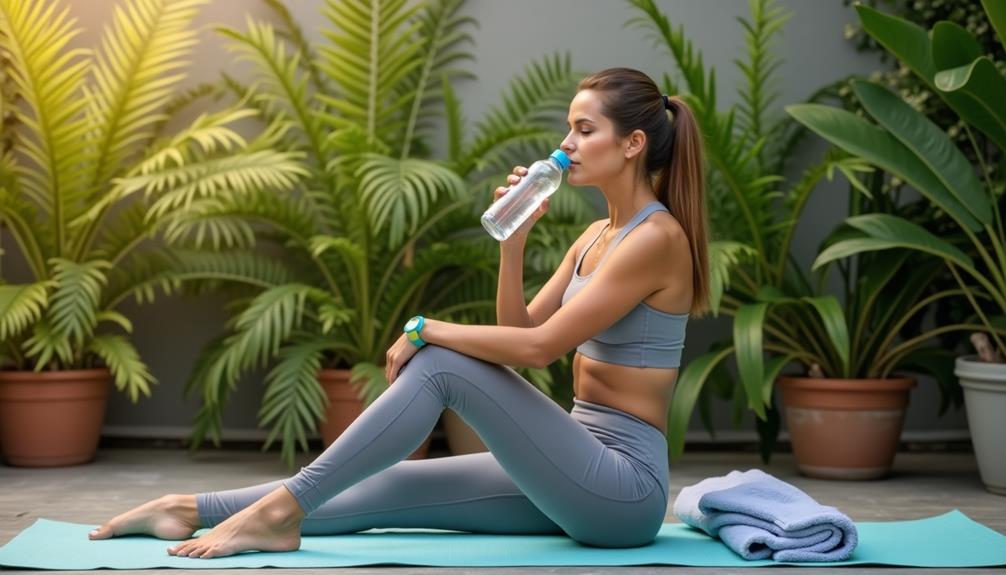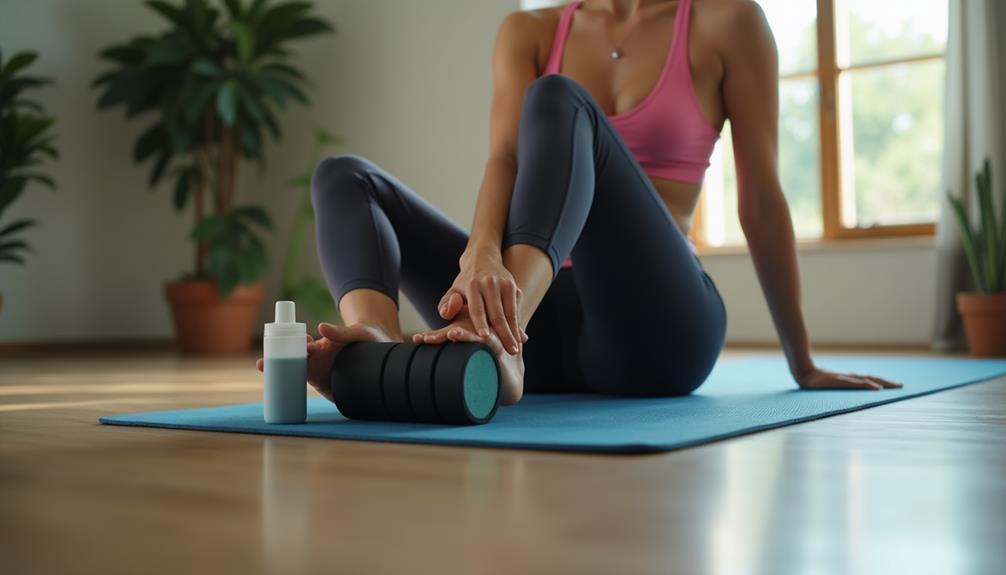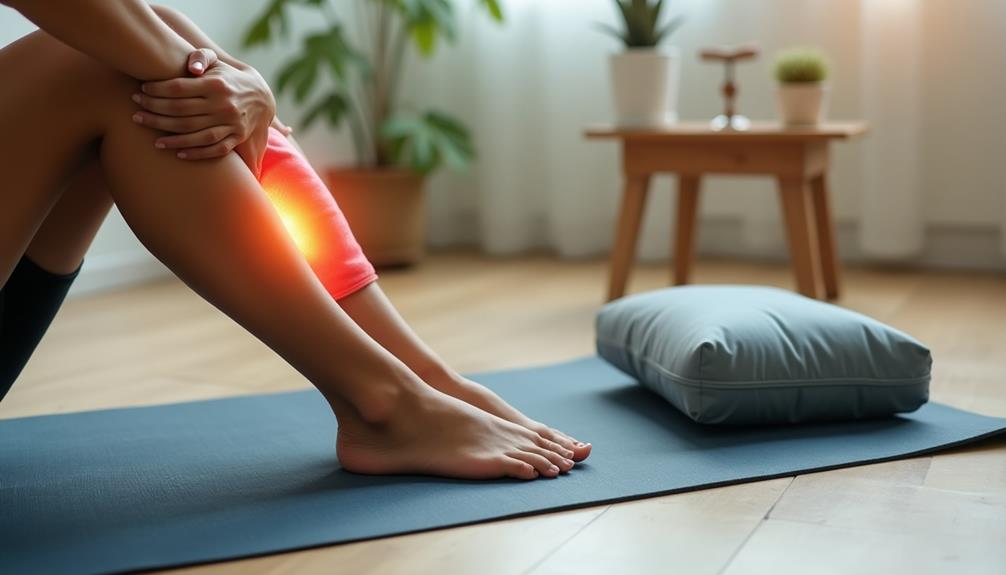To manage post-leg day soreness, start by staying hydrated. Drink 16-24 ounces of water within two hours after your workout. Next, incorporate active recovery; light exercises, like walking or yoga, boost blood flow and reduce soreness. Use foam rolling techniques to release tight muscles; focus on your quads, hamstrings, and calves. For relief, alternate between heat and cold therapy, depending on what feels best for you. Finally, prioritize nutrition and rest by consuming protein-rich foods for recovery and aiming for 7-9 hours of sleep each night. Keep exploring to discover more helpful recovery strategies.
Core Insights
- Hydrate adequately by drinking 16-24 ounces of water within two hours post-workout to aid recovery and muscle function.
- Incorporate active recovery techniques like walking or gentle stretching to promote blood flow and reduce muscle soreness.
- Utilize foam rolling on key muscle groups such as quads and hamstrings to release tension and improve circulation.
- Alternate between heat and cold therapy to relax muscles and alleviate discomfort effectively.
- Prioritize nutrition by consuming protein-rich foods and getting 7-9 hours of quality sleep for optimal recovery.
Stay Hydrated

Hydration is vital after a challenging leg day. When you push yourself, your muscles lose fluids through sweat, which can lead to dehydration. To recover effectively, it's essential to replenish those lost fluids. Drinking water helps maintain muscle function, reduces soreness, and supports recovery. Electrolyte replenishment drinks can be especially beneficial, offering a balanced mix of essential minerals to support hydration and muscle performance.
Aim to drink at least 16-24 ounces of water within the first two hours post-workout. If you've exercised intensely, consider electrolyte-rich drinks to replenish lost minerals. Listen to your body; if you're feeling fatigued or dizzy, it's a sign you need more hydration.
Incorporating hydration into your routine not only aids in recovery but also enhances your performance for future workouts. Make it a habit, and your body will thank you!
Incorporate Active Recovery

After you've focused on hydration, consider incorporating active recovery into your routine. Active recovery helps reduce muscle soreness and promotes blood flow to your legs. It doesn't mean you have to hit the gym hard again; light exercises can work wonders. Cold therapy compression wraps can also be beneficial for targeted relief and reducing inflammation in your leg muscles post-workout.
Try activities like walking, cycling, or swimming at a low intensity. These movements keep your muscles engaged without overexerting them. You might also consider yoga or gentle stretching to improve flexibility and relieve tension.
Aim for about 20 to 30 minutes of active recovery a few days post-leg day. Listen to your body, and adjust the intensity as needed. Remember, the goal is to support your recovery, not to push your limits further.
Use Foam Rolling Techniques

Foam rolling can be a game-changer for alleviating post-leg day soreness. This self-myofascial release technique helps break down muscle knots and improve blood flow. Start by choosing a foam roller with a density that suits your comfort level. High-density rollers offer intense deep tissue massage, while medium-density options provide a balance between comfort and effectiveness. Consider the texture and size of the roller for targeted muscle groups.
Roll slowly over your quads, hamstrings, and calves, pausing on any tight spots for about 20-30 seconds. Apply your body weight to the roller, adjusting the pressure as needed.
Make sure to stay hydrated before and after foam rolling, as this aids recovery. Aim to foam roll for 10-15 minutes, focusing on each muscle group. Incorporating this routine into your post-workout plan can notably reduce soreness and enhance flexibility, helping you bounce back quicker for your next leg day.
Apply Heat and Cold Therapy

After a day or two, switch to heat therapy. Heating pads or warm baths can help relax tight muscles and improve blood flow, promoting healing.
Make sure you alternate between heat and cold as needed. This combination can enhance recovery and ease discomfort.
Always listen to your body. If one method feels better than the other, stick with it. Remember, consistency is key for effective pain relief and improved mobility.
Prioritize Nutrition and Rest

To effectively manage post-leg day soreness, prioritize nutrition and rest as essential components of your recovery plan.
Nutrition Matters
After a tough workout, your muscles need fuel to repair. Focus on protein-rich foods like chicken, fish, or legumes to support recovery. Don't forget about carbohydrates; they replenish your energy levels. Incorporate fruits and vegetables for crucial vitamins and minerals, too.
Importance of Rest
Your body repairs itself during rest. Aim for 7-9 hours of quality sleep each night to promote muscle recovery. Listen to your body; if you feel fatigued, consider taking a rest day or practicing light activities like walking or stretching.
Frequently Asked Questions
How Long Should I Expect Soreness to Last After Leg Day?
You can expect soreness after leg day to last anywhere from 24 to 72 hours. It varies depending on your fitness level and workout intensity. Listen to your body and adjust your activity accordingly.
Can I Still Work Out if I'm Sore?
You might feel sore, yet that doesn't mean you can't work out. You can choose lighter exercises or focus on different muscle groups, allowing recovery while still keeping your routine active and engaging.
What Are the Signs of an Injury Versus Normal Soreness?
When you're evaluating soreness, look for sharp pain, swelling, or bruising—those could indicate an injury. Normal soreness typically feels like a dull ache and eases with movement, while injury symptoms persist or worsen.
Should I Take Pain Relievers for Muscle Soreness?
You shouldn't rely too much on pain relievers for muscle soreness. Instead, focus on natural recovery methods like stretching and hydration. If pain persists, consult a healthcare professional for guidance on appropriate treatment options.
Are There Specific Stretches to Alleviate Leg Soreness?
Yes, you can try specific stretches like hamstring stretches, quadriceps stretches, and calf stretches. These help improve flexibility and blood flow, reducing soreness. Make sure you hold each stretch for at least 30 seconds for best results.

